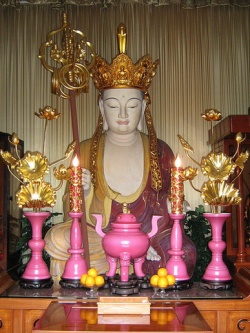Ksitigarbha Bodhisattva II
Ksitigarbha Bodhisattva (地藏王菩薩) is believed to have six incarnations but Buddhist sutras record only three. Perhaps that is the reason why he is believed to have been born a Korean in one incarnation who came to China to live, study and become a bodhisattva. Legend has it that he was born 1,500 years after the death of Sakyamuni (釋迦牟尼) in the kingdom of Silla (新羅) in Korea in 629 A.D. His name was Kim Kyo Gak (金喬覺). At the age of 24, Kim renounced the world and had his head shaven to become a monk. Then with a white dog, he came to China from Silla, the kingdom in southern Korea which was a vassal of Tang China. He then practiced Buddhist asceticism at Mount Jiuhua (九華山) at the county of Qingyang (青陽) in the prefecture of Chizhou in Jiangnan (江南池州) or present-day Anhui province. He is believed to sit in meditation alone atop a peak called Jiuzhifeng (九子峰) for 75 long years and was enlightened on the thirtieth day of the seventh moon in the sixteenth year of the Emperor Xuan-zhong’s regin or Kaiyuan (開元), or 728 A.D. He was 99 years old when he became a bodhisattva.
One story narrates an encounter between the future bodhisattva with an old man at Mount Jiuhua. Kim, the young Korean monk, asked the old man to whom the mountain belonged. Curious, the old man asked, “Why do you want to know?” The monk answered: “I wish to ask the owner for a tiny piece of land, the size of my saffron robe.” The old man, who was in fact the owner of the mountain, thought it wasn’t a preposterous request. “Well,” he told himself, “why not give it to the monk.” So he said to the monk: “Mount Jiuhua is mine. If you want a lot just large enough for your robe, it’s yours from now on.” “You won’t regret?” the monk asked. Without waiting for an answer, the monk took off his robe and threw it toward the mountain. The robe unfurled and covered the whole of the mountain. Mount Jiuhua then became the Pure Land of Ksitigarbha.
But there is another Pure Land of Ksitigarbha. That is in India. It is called Kharadiya Mountain near the ancient city of Gaya. Well, Ksitigarbha, after all, is the Sanskrit name. It is said the Buddha once gave a lecture about Ksitigarbha Bodhisattva on that mountain. Just before he began to speak, all sorts of incredible things happened. Clouds appeared in every fantastic formation around the mountain and all in the audience saw themselves decorated with flowers as well as jewels and other ornaments. The radiance of the jewels spread in every direction. The Buddha proclaimed the place is the Pure Land of other buddhas.
According to another Chinese version of the story of Ksitigarbha, the old man the young Korean monk met was no other than a Tang court minister, Lord Min (閔公). He was a devout Buddhist. When he knew the young monk came to Mount Jiuhua, he promptly invited him for a dinner. During the meal, the young monk asked his host for a piece of land to build a temple. Lord Min said his guest might have as much land as the shadow of the latter’s Buddhist robe could cover. Thereupon, the robe was unfurled and thrown into the air. Its shadow covered the whole mountain.
